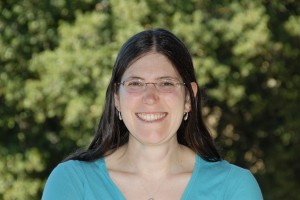Susanne Rafelski, Ph.D.
Assistant Professor
University of California Irvine
3208 Natural Sciences I
Irvine, CA 92697
Tel: (949) 824-4888
Fax: (949) 824-4709
Email: susanner@uci.edu
Website: Lab Homepage
Control of mitochondrial network size, topology and function in budding yeast cells.
The long-term goal of my lab is to understand the spatial and dynamic organization of the cell at all levels of complexity:
-How is the 3-dimensional geometry (size, shape, position, dynamics) of organelles and intracellular structures generated at the molecular level, regulated system-wide to respond to the needs of the cell, and integrated to organize the cell?
-How does improper internal organization contribute to the cellular basis of disease?
Model system and approach:
The geometry of mitochondrial networks is vital to their cellular functions, regulated by the cell, and visualizable by light microscopy. Working in budding yeast allows us to integrate new knowledge of the control of mitochondrial network morphology with that of other cellular processes such as cell cycle and cellular metabolism due to the phenomenal genetic techniques and systems-level analysis possible in this organism.
We take an interdisciplinary approach, combining 3D microscopy and image processing with molecular genetics and computational methods.
Current research directions:
1. Quantifying mitochondrial networks in 3D
We have developed a novel computational method to automatically and consistently measure the physical size and topology of mitochondrial networks in budding yeast. We do this by considering the mitochondrial network a mathematical graph with edges represented by the tubules and nodes represented by the branchpoints. We continue to improve these methods to analyze mitochondrial fusion and fission dynamics and mitochondrial networks in other cell types.
2. Control of mitochondrial network size
We study the fundamental question of how organelle size scales with cell size to ensure proper cellular physiology and organelle inheritance upon division. We have found that mitochondrial network size scaling in budding yeast is regulated in the bud at the expense of the mother. We continue to investigate the molecular and cellular mechanisms that sense and adjust the mitochondrial content in the bud. We are also exploring the functional consequences of the loss of mitochondrial content in aging mother cells.
3. Control of mitochondrial network topology
We are performing a comprehensive quantitative analysis of the topology of mitochondrial networks. We combine experiment and simulations to step-wise identify the contributions of the density and distribution of tubules, the physical size of the network, and fission and fusion dynamics toward a detailed understanding of the basic underlying principles that control network topology.
4. Bi-directional feedback between network morphology and mitochondrial functions
Our quantitative approach allows us to address how mitochondrial network size and topology effect and are effected by mitochondrial functions at the level of individual cells. Our understanding of the mechanisms that control network size and topology will allow us to precisely manipulate network morphology to determine the resultant changes in function. By taking advantage of yeast genetics we can also alter mitochondrial function directly and assess how this contributes to the control of network morphology and dynamics.
Recent Publications
- Pesce, GC, Rafelski, SM, Bernales, S, Viana, MP, da F. Costa, L, Marshall, WF, Walter, P. A mitotic cell cycle checkpoint controls mitochondrial expansion during cell division. In Revision.
-
Viana MP, Lim S, Rafelski SM. Methods Cell Biol. 2015;125:77-93. doi: 10.1016/bs.mcb.2014.10.003. Epub 2015 Jan 8.
-
Jayashankar V, Rafelski SM. Curr Opin Cell Biol. 2014 Feb;26:34-40. doi: 10.1016/j.ceb.2013.09.002. Epub 2013 Oct 8. Review.
-
Rafelski, SM (2013). Mitochondrial network morphology: building an integrative, geometrical view. BMC Biology 11:71.
- Rafelski, SM, Viana, MP, Zhang, Y, Chan, YHM, Thorn, KS, Yam, P, Fung, JC, Li, H, da F. Costa, L, Marshall, WF. (2012) Mitochondrial network size scaling in budding yeast. Science 338(6108): 822-4.
- Wasilewski, M, Semenzato, M, Rafelski, SM, Robbins, JR, Bakardjiev, AI, Scorrano, L. (2012) Optic Atrophy1- dependent mitochondrial remodeling controls steroidogenesis in trophoblasts. Current Biology, 22(13): 1228-34.
- Melton-Witt, JA*, Rafelski, SM*, Portnoy, DA, Bakardjiev, AI. (2012) Oral infection with signature-tagged Listeria monocytogenes reveals organ-specific growth and dissemination routes in guinea pigs. Infection & Immunity 80(2): 720-32. [*co-first authors]
- Rafelski, SM*, Keller, LC*, Alberts, JB, Marshall, WF. (2011) Apparent diffusive motion of centrin foci in living cells: implications for diffusion-based motion in centriole duplication. Physical Biology 8(2): 026010. [*co-first authors]
- Rafelski, SM*, Alberts, JB*, Odell GM. (2009) An experimental and computational study of the effect of ActA polarity on the speed of Listeria monocytogenes actin-based motility. PLOS Computational Biology 5(7): e1000434. [*co-first authors]
- Rafelski, SM and Marshall, WF. (2008) Building the cell: engineering design principles of cellular architecture. Nature Reviews Molecular Cell Biology 9(8): 593-602.
- Rafelski, SM, Theriot, JA. (2006) Mechanism of polarization of Listeria monocytogenes surface protein ActA. Molecular Microbiology 59(4):1262–1279.
- Rafelski, SM, Theriot, JA. (2005) Bacterial shape and ActA distribution affect initiation of Listeria monocytogenes actin-based motility. Biophysical Journal 89(3):2146-58.
- Rafelski, SM, Theriot JA. (2004). Crawling toward a unified model of cell motility: Spatial and temporal regulation of actin dynamics. Annual Review of Biochemistry 73:209-239.


